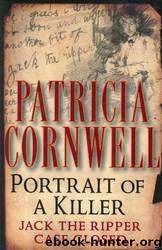Portrait of a Killer: Jack the Ripper--Case Closed by Patricia Cornwell

Author:Patricia Cornwell [Cornwell, Patricia]
Language: eng
Format: epub
Tags: True Crime, General
ISBN: 9780399149320
Google: C3TUKNroaYkC
Amazon: 0399149325
Publisher: Penguin
Published: 2002-11-10T16:00:00+00:00
CHAPTER SEVENTEEN
THE STREETS UNTIL DAWN
Gatti’s Hungerford Palace of Varieties was one of the most vulgar music halls in London. It was Sickert’s favorite haunt the first eight months of 1888, and he went there several nights a week.
Built into a 250-foot-wide arch underneath the South Eastern railway near Charing Cross Station, Gatti’s could seat six hundred, but on some nights as many as a thousand rowdy spectators crowded in for hours of drinking, smoking,and sexually charged entertainment. The popular Katie Lawrence shocked polite society by dressing in men’s breeches or a loose, short frock that exposed more female flesh than was deemed decent at the time. Music-hall stars Kate Harvey and Florence Hayes as “The Patriotic Lady” were regulars when Sickert was making his quick sketches in the flickering lights.
Cleavage and exposed thighs were scandalous, but nobody seemed to worry much about the exploitation of the female child stars prancing about singing the same racy songs as the adults. Girls as young as eight years old dressed in costumes and little frocks and aped sexual awareness that invited pedophilic excitement and became the material for a number of Sickert’s paintings. Art historian Dr. Anna Gruetzner Robins explains that “among decadent writers, painters, and poets, there was something of a cult for the supposed sweetness and innocence of child music-hall performers.” In her book Walter Sickert: Drawings, she provides new insight into Sickert’s artistic interpretations of the female performers he watched night after night and followed from music hall to music hall. His sketches are a glimpse into his psyche and how he lived his life. While he did not mind impetuously giving away a painting, he would not part with the on-the-spot drawings he made on postcards and other small pieces of cheap paper.
To look at these faint pencil sketches in the collections at the Tate Gallery, the University of Reading, the Walker Art Gallery in Liverpool, and Leeds City Art Gallery is to slip inside Sickert’s mind and emotions. His hasty artistic strokes capture what he saw as he sat in a music hall, gazing up at the stage. They are snapshots made through the lens of his own fantasies. While other men leered and egged on the half-naked performers, Sickert sketched dismembered female body parts.
One might argue that these drawings were Sickert’s attempt at improving his technique. Hands, for example, are difficult, and some of the greatest painters had their struggles with hands. But when Sickert was sitting in his box or several rows back from the stage and making sketches on his little bits of paper, he wasn’t perfecting his art. He was drawing a head severed from its neck; arms with no hands; a torso with no arms; plump chopped-off naked thighs; a limbless torso with breasts bulging out of a low-cut costume.
One might also argue that Sickert was thinking about new ways to reposition the body in a manner that wasn’t stilted or posed. Perhaps he was trying out new methods. He would have seen Degas’s pastel nudes.
Download
This site does not store any files on its server. We only index and link to content provided by other sites. Please contact the content providers to delete copyright contents if any and email us, we'll remove relevant links or contents immediately.
Mindhunter: Inside the FBI's Elite Serial Crime Unit by John E. Douglas & Mark Olshaker(7848)
Wiseguy by Nicholas Pileggi(4598)
Hitman by Howie Carr(4382)
Room 212 by Kate Stewart(4113)
Secrecy World by Jake Bernstein(3788)
Breaking Free by Rachel Jeffs(3629)
Killers of the Flower Moon: The Osage Murders and the Birth of the FBI by David Grann(3622)
Papillon (English) by Henri Charrière(3279)
Killers of the Flower Moon by David Grann(3257)
Say Nothing by Patrick Radden Keefe(3069)
The Secret Barrister by The Secret Barrister(3012)
American Kingpin by Nick Bilton(2983)
Molly's Game: From Hollywood's Elite to Wall Street's Billionaire Boys Club, My High-Stakes Adventure in the World of Underground Poker by Molly Bloom(2973)
Mysteries by Colin Wilson(2889)
In Cold Blood by Truman Capote(2690)
I'll Be Gone in the Dark by Michelle McNamara(2570)
Signature in the Cell: DNA and the Evidence for Intelligent Design by Stephen C. Meyer(2505)
Rogue Trader by Leeson Nick(2478)
Bunk by Kevin Young(2466)
